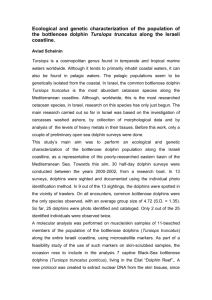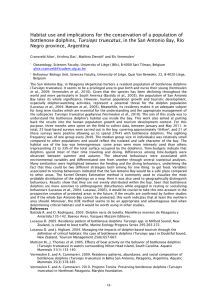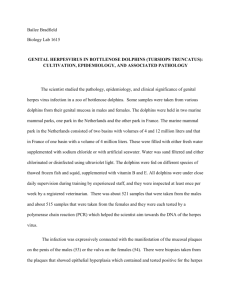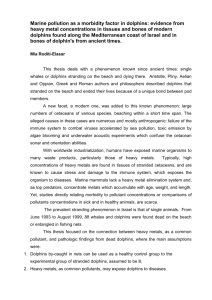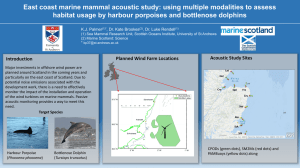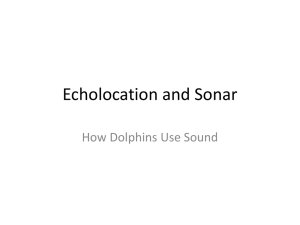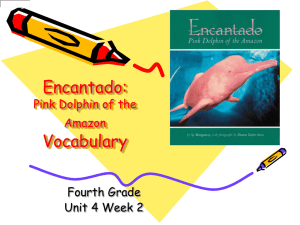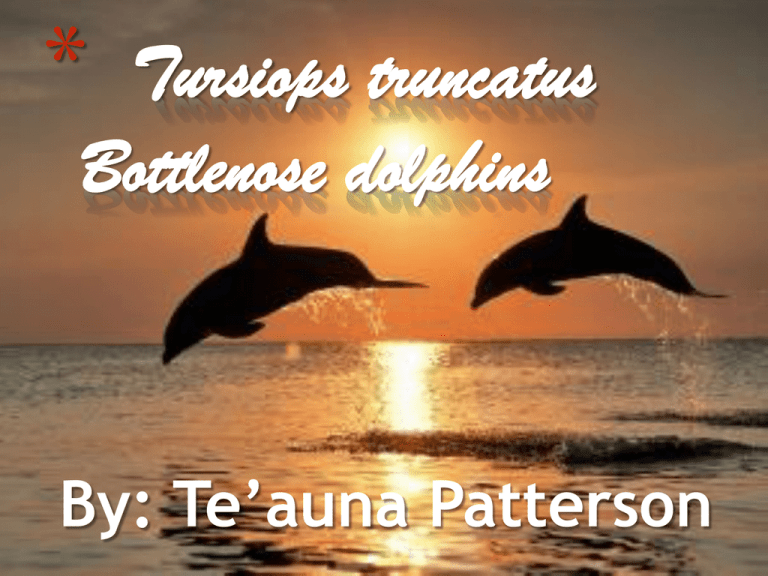
*
Tursiops truncatus
Bottlenose dolphins
By: Te’auna Patterson
* Short fat snout
* Snout connects to slanted head
* Jaw is similar to under bite
* Upper Body is grey with hints of purple
* White belly, and light grey sides
* Upper Body turns black after death
* 76-98 teeth
* Adults may reach 3.5 m
* Two kinds of bottlenose dolphins
*
*White belly, and light grey sides
*Upper Body turns black after death
*76-98 teeth
*Adults may reach 3.5 m
*Two kinds of bottlenose dolphins
*
*Pectoral flippers are similar to land
mammals fingers
*Pectoral Flippers are contain thick
cartilage in between the bone
*Pectoral Flippers are slightly curved
at the tip
*Pectoral Flippers are used to steer
*Pectoral Flippers are used with
flukes to stop
*
* The blood flow in flippers helps to maintain
homeostasis
* Instead of giving off heat into the environment
they circulate it from arteries to veins
* In order to cool down blood flow decrease
towards the core but increases towards the
surface
* Dorsal Fin is made of thick tissue without bones
like the flukes
*
*Some dolphins do not have a
dorsal fin
*Dorsal fins help to keep balance
*Flukes are used to propel the
animal
*The size of the flukes is around
1/5 of the dolphins body
*
* Dolphins are NOT endangered
* Live in water between 50 and 90 degrees
Fahrenheit
* Some migrate seasonally
* Everywhere but polar waters (tropical,
subtropical, and warm temperate)
*
*Some live in deep water or shallower water
closer to shore
*There are about 67,000 Bottlenose
dolphins in the United States’ Gulf of
Mexico
*In the Western North Pacific and along
Japanese coasts there are about 35,000
*
* The size of the dolphin is based on its’ habitat
* Smaller dolphins are Coastal
* Larger Dolphins are Offshore
* In the Western North Atlantic there are about
11,700
*
* Diet depends on habitat
* Coastal dolphins feed on invertebrates
* Deep water Dolphins feed on squid and pelagic
fish
* They consume 4-5% of their body weight a day
* Follow fisherman to catch discarded fish or
bait
* They swallow their food whole
*
* They beach their prey to catch them easier
* They use echolocation to stun prey
* Use teeth to grab prey while tongue moves it
down the throat
* In Australia, they put a sponge on their nose to
protect it as they forage for food on the
bottom of the ocean
*
*Twice that of humans
*Auditory part of brain is extremely
developed
*Frequency range of 1-150 kHz
*Hear best between 40 and 100 kHz
*Hear through their lower jaw
*
http://www.seaworld.org/animal-info/info-books/bottlenose/communication.htm
*Can see in and out of water
*See best in water
*Binocular vision in air
*Have binocular and monocular vision in
water
*Have a light reflecting portion that makes
it easy to see in dim light
*
* Female dolphins initiate courtship
* May breed throughout the year
* “Just before mating, a male rubs and nuzzles a
female. he may also exhibit an "S-curve" posture,
in which he lifts his head up and points his tail
flukes down”
* Calves nurse under water
* Calves nurse for a year and a half
* The dolphin that helps birth the calf is the auntie
*
* Dolphins hold their breath under water
* Their blowhole is their way of breathing
* Breathing takes about .3 seconds
* Their normal breathing consists of taking 2-3
breaths per minute
* Dolphins have blubber that insulates their
bodies
*
* Normal body temperature is 98.4'F
* Spend 1/3 of their day asleep
* An ongoing study says that deep sleep occurs in
one brain hemisphere at a time
* Groups of dolphins are called pods
* The average pod is seven animals
* Pods are based on age sex and reproduction
characteristics
*
* On the US coast pods of mothers and newborn
calves are common
* Teen dolphins occur in groups with males and
females
* Adult male dolphins travel alone or in groups of
3
* The deeper the water the bigger the pod
* Mother-calf bonds last for a long time
*
* Establish dominance by fighting or smashing
their tails on water
* Emit bubble clouds when angry
* Dolphins flirt by biting each other’s heads and
scratching teeth
* Dolphins can jump 16 feet in the air
*
* Jumping and landing on their backs or sides is
called a breach
* Dolphins help each other when hurt by bringing
them to the surface to breathe
* Albino Dolphins can be pink
*
* “Bottlenose Dolphins (Tursiops truncatus).” The
Mammals of Texas. N.p., n.d. Web. 8 July
2011.
<http://www.nsrl.ttu.edu/tmot1/turstrun.htm
>.
* Jenkins, Jessica, Phil Meyers, and Tanya Dewey.
“Tursiops truncatus: Bottlenosed Dolphin.”
Animal Diversity Web. U of Michigan Museum of
Zoology, n.d. Web. 8 July 2011.
<http://animaldiversity.ummz.umich.edu/site/
accounts/information/Tursiops_truncatus.html
>.
*
* “Bottlenose Dolphins.” Sea World.
SeaWorld/Busch Gardens Animal Information
Database, n.d. Web. 8 July 2011.
<http://www.seaworld.org/infobooks/bottleno
se/home.html>.
* Pictures 1, 2, and 3 also came from this source
*


